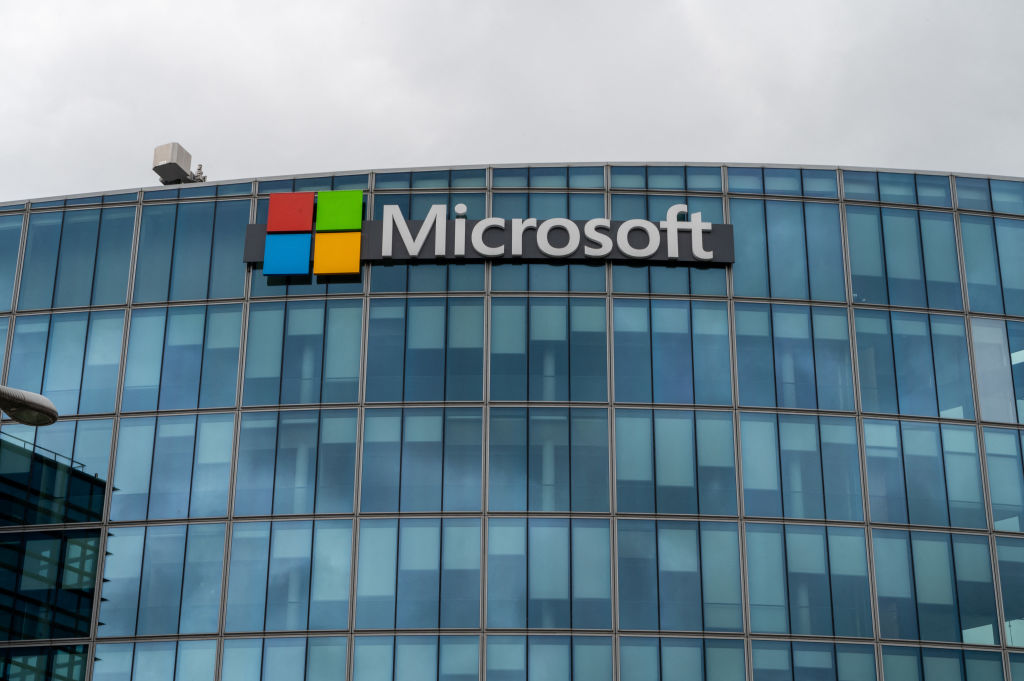Microsoft Stock: Innovation Spurs Its 100,000% Return
Microsoft's ability to recognize the "next big thing" has allowed sales – and its share price – to grow exponentially over the years.


Editor's note: This is the final segment of a 13-part series about companies whose shares have amassed 100,000% returns for investors and the path taken to generate such impressive gains over the long term. See below for links to the other stocks in this series.
Microsoft (MSFT), founded in 1975 by Bill Gates and Paul Allen, has evolved from a small software vendor into a global technology powerhouse. The company's growth over the years can be attributed to its ability to innovate continuously, adapt to changing market dynamics, and expand its product portfolio.
The first big company to trust Microsoft and give it a big leg up was IBM. Microsoft was tasked with creating an operating system for IBM's line of personal computers, for which they developed the Microsoft Disk Operating System (MS-DOS).

Sign up for Kiplinger’s Free E-Newsletters
Profit and prosper with the best of expert advice on investing, taxes, retirement, personal finance and more - straight to your e-mail.
Profit and prosper with the best of expert advice - straight to your e-mail.
A few years later, Microsoft launched an improved operating system which would eventually become its flagship product, the Windows operating system. This revolutionized personal computing by providing, according to some accounts, an easy-to-use interface and compatibility with a wide range of software applications.
This innovation set the stage for Microsoft's rapid growth in the 1980s and 1990s. As of 2024, Windows continues to dominate the desktop operating system market with a market share of approximately 72% – despite facing competition from Apple's macOS and various Linux distributions.
The company's Personal Computing segment, which includes Windows products, contributed 25% to Microsoft's revenues in 2024.
Another driver of Microsoft's success is its productivity software. Introduced in the late 1980s, Microsoft Office – which includes Word, Excel, PowerPoint, and Outlook – quickly became the industry standard for business applications. Its success was driven by its integration with the Windows operating system.
Today, Microsoft 365, the cloud-based version of the Office suite, commands a market share of 30% in the productivity software market, second only to Google's Office suite.
The launch of Microsoft 365 marked Microsoft's transition of its software products to a subscription model. This shift has provided a more predictable revenue stream, reduced software piracy, and increased customer retention by offering continuous updates and new features.
Further, recognizing the shift towards cloud computing, Microsoft launched Azure in 2010. This move into cloud services marked a significant strategic pivot for Microsoft, aligning the company with the rapidly growing demand for cloud-based solutions.
Azure has since grown to become one of the leading cloud platforms globally, competing directly with Amazon Web Services (AWS) and Google Cloud.
In 2024, Microsoft's Intelligent Cloud segment, driven by Azure and other cloud services, delivered the biggest share of its total revenues at 43%.
Despite the continued success of its product lineup, Microsoft did not rest on its laurels. Historically known for its closed ecosystem, Microsoft has embraced open-source software and cross-platform compatibility in recent years.
The company's acquisition of GitHub, support for Linux on its Azure cloud platform, and the development of cross-platform tools like Visual Studio Code reflect a strategic shift towards openness and collaboration.
This approach has helped Microsoft attract a broader range of developers and enterprises, enhancing its relevance in a multi-platform world.
Looking ahead, Microsoft's investments in emerging technologies, such as artificial intelligence (AI), mixed reality, and quantum computing, are expected to drive future innovation and growth.
As a major OpenAI investor, Wall Street is expecting Microsoft to be one of the first companies to 'monetize' AI. Integrating AI into Azure and Microsoft 365 will likely play a pivotal role in shaping the future of work and digital transformation.
The arc of Microsoft's success has rested on its ability to recognize "the next big thing" in computing and adapt its products or create new ones to earn a material share in several growing markets.
You can see this in its sales which have grown from $39.7 billion in 2005 to $211.9 billion in 2023, an average annual growth rate of 8.7%, with earnings per share growing from $1.13 to $11.86, or 12.5% annually.
Earnings per share have grown because of share buybacks, yes, but margin improvement has played a role as well. The gross margin over the past five years has grown from 64.6% to 68.9%, which is not too shabby.
The real gains, though, have occurred at the operating level. Who knew Microsoft was a cost-cutter? But it is. The operating margin has grown from 27.4% to 42.1%.
We looked at financial statements going back to 2005, which means the results showed the last three years of Gates' tenure with the company. The operating margin for those three years was more or less constant.
Steve Balmer and Satya Nadella have been more vigorous in wielding the knife, and this is reflected in Microsoft's stellar operating margin.
Note: This content first appeared in Louis Navellier's latest book, The Sacred Truths of Investing: Finding Growth Stocks that Will Make You Rich, which was published by John Wiley & Sons, Inc.
Other 100,000% return stocks
- McDonald's Stock: How Small Changes Have Led to 100,000% Returns
- How Amazon Stock Became a Member of the 100,000% Return Club
- M&A Is Why UnitedHealth Group Stock Is a Member of the 100,000% Return Club
- Sherwin-Williams Is a Sleeper of the 100,000% Return Club
- Dealmaking Drives HEICO Stock's 100,000% Return
- Adobe Stock's Path to a 100,000% Return Is Impressive
- Apple's 100,000% Return Is a Result of Innovation, Brand Loyalty and Buybacks
- Home Depot's Winning Ways Fueled Its 100,000% Return
- It's No Surprise That Berkshire Hathaway's in the 100,000% Return Club
- Nvidia Stock's Been Growing for Years. Just Look At Its 100,000% Return
- Relentless Leadership Drives Oracle Stock's 100,000% Return
- Walmart's Transformative Ways Spark a 100,000% Stock Return
Get Kiplinger Today newsletter — free
Profit and prosper with the best of Kiplinger's advice on investing, taxes, retirement, personal finance and much more. Delivered daily. Enter your email in the box and click Sign Me Up.

-
 Two Don'ts and Four Dos During Trump's Trade War
Two Don'ts and Four Dos During Trump's Trade WarThe financial rules have changed now that tariffs have disrupted the markets and created economic uncertainty. What can you do? (And what shouldn't you do?)
By Maggie Kulyk, CRPC®, CSRIC™
-
 I'm Single, With No Kids: Why Do I Need an Estate Plan?
I'm Single, With No Kids: Why Do I Need an Estate Plan?Unless you have a plan in place, guess who might be making all the decisions about your prized possessions, or even your health care: a court.
By Cynthia Pruemm, Investment Adviser Representative
-
 Two Don'ts and Four Dos During Trump's Trade War
Two Don'ts and Four Dos During Trump's Trade WarThe financial rules have changed now that tariffs have disrupted the markets and created economic uncertainty. What can you do? (And what shouldn't you do?)
By Maggie Kulyk, CRPC®, CSRIC™
-
 I'm Single, With No Kids: Why Do I Need an Estate Plan?
I'm Single, With No Kids: Why Do I Need an Estate Plan?Unless you have a plan in place, guess who might be making all the decisions about your prized possessions, or even your health care: a court.
By Cynthia Pruemm, Investment Adviser Representative
-
 Most Investors Aren't as Diversified as They Think: Are You?
Most Investors Aren't as Diversified as They Think: Are You?You could be facing a surprisingly dangerous amount of concentration risk without realizing it. Fixing that problem starts with knowing exactly what you own.
By Scott Noble, CPA/PFS
-
 My First $1 Million: Literacy Interventionist, 59, Colorado
My First $1 Million: Literacy Interventionist, 59, ColoradoEver wonder how someone who's made a million dollars or more did it? Kiplinger's new My First $1 Million series uncovers the answers.
By Joyce Lamb
-
 Will My Children Inherit Too Much?
Will My Children Inherit Too Much?If you worry about how your children will handle an inheritance, you're not alone. Luckily, you have options — from lifetime gifting to trusts — that can help.
By Mallon FitzPatrick, CFP®, AEP®, CLU®
-
 Charitable Giving Lessons From Netflix's 'Apple Cider Vinegar'
Charitable Giving Lessons From Netflix's 'Apple Cider Vinegar'Charity fraud is rife, and a Netflix series provides a timely warning about donating money to a good cause without looking into its background.
By Peter J. Klein, CFA®, CAP®, CSRIC®, CRPS®
-
 What Happens To Mortgage and Savings Rates If Trump Fires Jerome Powell?
What Happens To Mortgage and Savings Rates If Trump Fires Jerome Powell?President Donald Trump expressed his desire to remove Fed Chair Jerome Powell. If the president is successful, how would it impact your savings accounts?
By Sean Jackson
-
 Why You Need a Trusted Contact for Your Brokerage
Why You Need a Trusted Contact for Your BrokerageYour brokerage or bank needs someone to reach out to if it's concerned you're experiencing fraud or cognitive decline. That's where a trusted contact can help.
By John Waggoner